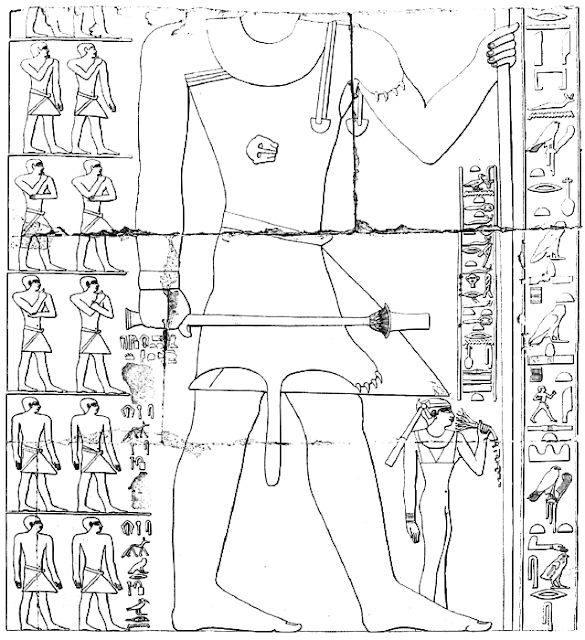 Mereruka, standing at the north end facing south, is accompanied by the smaller scale figure of his wife, who stands in front of him with a lotus blossom at her nose. Except for his head being missing, this figure of Mereruka has survived intact. He wears a leopard skin, which hangs over his triangular kilt. He holds his staff of office in his left hand and a sceptre in his right.
Mereruka, standing at the north end facing south, is accompanied by the smaller scale figure of his wife, who stands in front of him with a lotus blossom at her nose. Except for his head being missing, this figure of Mereruka has survived intact. He wears a leopard skin, which hangs over his triangular kilt. He holds his staff of office in his left hand and a sceptre in his right.
"… for his tomb of the beautiful West, in peace, in peace."(then possibly)
"How happy she is in respect of it.". The texts in the registers include the words spoken by the craftsmen or a short description.

The bottom two registers show metal workers . Starting with the upper one, they contain : weighing then smelting of gold ore, the pouring of the molten metal and finally (of what survives) the beating of the gold into foil. The lower of the two registers shows the production of collars and pectorals. The left-hand person of the middle pair states: "This is very beautiful, comrade."
; whilst the left-hand one of the couple to their right says : "Hurry up you, make it happen."
. In the intermediate, narrower, register which probably represents a shelf, are finished objects including headdresses, pectorals and collars. A similar shelf appears in the upper of the registers containing a variety of vases, some of which are on stands.
Immediately above the metal working registers is the most complete one , showing the hauling on sledges with statues of Mereruka towards his tomb. This register possibly represents a street separating two different workshops.
Above the "street" are the remains of three more registers :
The lower one shows carpenters at work on a bed and two others are occupied with the construction of a chest and its lid.
The middle one shows the production of various vessels, of different shapes and sizes, which are stored in a sub-register (a storeroom ?) above. The conversation is: (left) "Hurry up, you."
, (right) "This nXnm-jar is very beautiful."
. Next to the potters, two men construct a scaffolding, of which only half survives. This is made of a forked piece, held upright by three stays, supporting a horizontal beam. The character on the right says: "Press down hard on that pole, (put your) butt on it.".
The upper register, of which only the lower portion remains, has the legs of several characters. From what little remains it is impossible to determine what activity is taking place.



Comments
Post a Comment